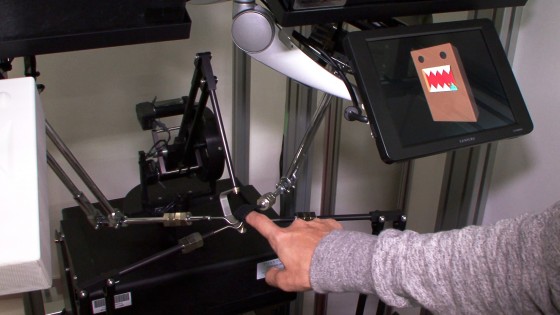
Robohub.org
Feel the edges and contours of virtual objects with this haptic system from NHK

With the aim of implementing a television service which allows viewers to touch virtual objects, NHK is developing a tactile system which applies stimuli to five points on one finger, making objects feel more real than when using previous systems.
“This device assists people with a visual disability, through what’s called the tactile or kinesthetic sense. It communicates a 3D shape or 2D graph of an object shown on a TV, such as a work of art, as a sensation felt by the hand.”
“The system detects spatial position data for the fingertip in 1/1000 of a second. The finger moves freely if there isn’t anything present, but when it approaches something, it becomes unable to go into the object. By tracing with your finger like this, you can feel that there’s a continuous rough surface there. Also, the jagged feeling of the tooth makes the sensation similar to that of touching an actual object.”
In previous systems, a force was applied to the entire fingertip, and when angular parts of an object were presented, the fingertip tended to deviate from the virtual object, making it hard to understand the object’s shape. But this device makes the corners of an object, in particular, feel natural, by generating a force at five points.
“Now, Domo-kun’s body is one object, while the tooth is another object. The texture can be changed for each object. Here, the tooth alone has been made slightly hard. In that case, if we create a different object using CG, we can do this kind of thing.”
“This is slightly different from a texture that’s actually felt by the skin. For instance, if you hold a pen, you can perceive textures through the pen. This system reproduces that kind of sensation.”
“From now on, we’d like to simplify this device. We want to extend the range of movement of the fingers so that curved surfaces are also recognizable, while keeping the advantages of the current version.”
tags: AR, c-Research-Innovation, perception




